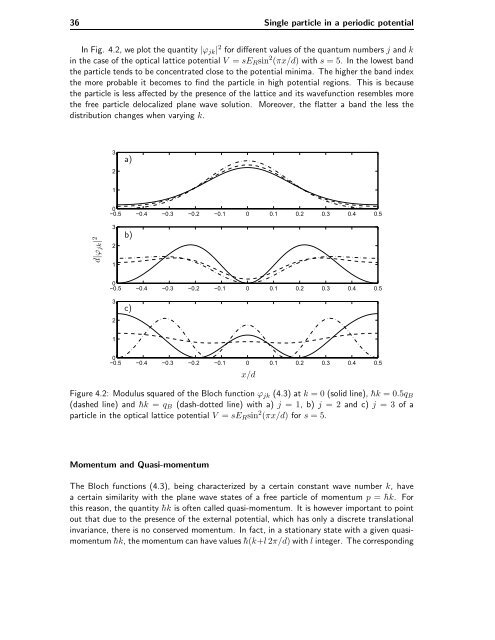Bose-Einstein Condensates in Rotating Traps and Optical ... - BEC
Bose-Einstein Condensates in Rotating Traps and Optical ... - BEC
Bose-Einstein Condensates in Rotating Traps and Optical ... - BEC
Create successful ePaper yourself
Turn your PDF publications into a flip-book with our unique Google optimized e-Paper software.
36 S<strong>in</strong>gle particle <strong>in</strong> a periodic potential<br />
In Fig. 4.2, we plot the quantity |ϕjk| 2 for different values of the quantum numbers j <strong>and</strong> k<br />
<strong>in</strong> the case of the optical lattice potential V = sERs<strong>in</strong> 2 (πx/d) with s =5. In the lowest b<strong>and</strong><br />
the particle tends to be concentrated close to the potential m<strong>in</strong>ima. The higher the b<strong>and</strong> <strong>in</strong>dex<br />
the more probable it becomes to f<strong>in</strong>d the particle <strong>in</strong> high potential regions. This is because<br />
the particle is less affected by the presence of the lattice <strong>and</strong> its wavefunction resembles more<br />
the free particle delocalized plane wave solution. Moreover, the flatter a b<strong>and</strong> the less the<br />
distribution changes when vary<strong>in</strong>g k.<br />
d|ϕjk| 2<br />
3<br />
2<br />
1<br />
0<br />
−0.5 −0.4 −0.3 −0.2 −0.1 0 0.1 0.2 0.3 0.4 0.5<br />
3<br />
2<br />
1<br />
0<br />
−0.5 −0.4 −0.3 −0.2 −0.1 0 0.1 0.2 0.3 0.4 0.5<br />
3<br />
2<br />
1<br />
a)<br />
b)<br />
c)<br />
0<br />
−0.5 −0.4 −0.3 −0.2 −0.1 0 0.1 0.2 0.3 0.4 0.5<br />
x/d<br />
Figure 4.2: Modulus squared of the Bloch function ϕjk (4.3) at k =0(solid l<strong>in</strong>e), ¯hk =0.5qB<br />
(dashed l<strong>in</strong>e) <strong>and</strong> ¯hk = qB (dash-dotted l<strong>in</strong>e) with a) j =1,b)j =2<strong>and</strong> c) j =3of a<br />
particle <strong>in</strong> the optical lattice potential V = sERs<strong>in</strong> 2 (πx/d) for s =5.<br />
Momentum <strong>and</strong> Quasi-momentum<br />
The Bloch functions (4.3), be<strong>in</strong>g characterized by a certa<strong>in</strong> constant wave number k, have<br />
a certa<strong>in</strong> similarity with the plane wave states of a free particle of momentum p =¯hk. For<br />
this reason, the quantity ¯hk is often called quasi-momentum. It is however important to po<strong>in</strong>t<br />
out that due to the presence of the external potential, which has only a discrete translational<br />
<strong>in</strong>variance, there is no conserved momentum. In fact, <strong>in</strong> a stationary state with a given quasimomentum<br />
¯hk, the momentum can have values ¯h(k+l 2π/d) with l <strong>in</strong>teger. The correspond<strong>in</strong>g




